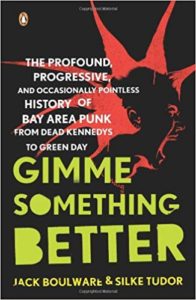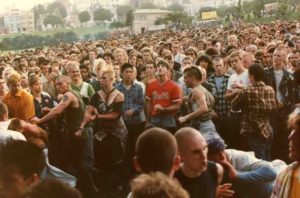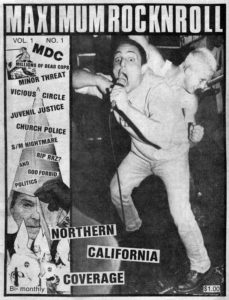
Jack Boulware & Silke Tudor (Penguin Books, 2009)
Gimme Something Better is an interesting book to revisit for me right now as a longtime Bay Area resident watching the effects of gentrification on local culture. California was the “capitol of the kooks” when I first arrived here in 1988; that’s how I liked it and would start inching towards the local punk scene several years later. Green Day and Rancid were achieving mainstream success as I began regularly attending shows in the underground scene that spawned them. AFI was still a scrappy punk band then; playing shows at Gilman Street and UC Berkeley keg parties. Although Davey Havok gets a quick chance to tell their story, Gimme Something Better’s lineage ends roughly around 1994-95 with Green Day and Rancid’s ascension from the underground. Anything else beyond that is another story for another time.

While Gimme Something Better does profile a number of bands, readers should not expect it to serve as a guide to their recorded output. You won’t find discographies listed in the back like with Stephen Blush’s American Hardcore. Gimme Something Better is about Bay Area punk as a social and cultural phenomenon. Many visible (and sometimes notorious) figures on the scene offer their perspectives, from band members to zine writers to skinhead street thugs and even the local sheriff! We read about venues like the Farm and Ruthie’s Inn, as well as cliques like the DMR punk girl gang and the Jak’s skate team. Punk rockers often lived marginal lifestyles, which produces chapters about the Vats and other abandoned living spaces (i.e. squats) in San Francisco. Gimme Something Better allows chapters to exist on Nazi skinhead crews AND the nearly-forgotten Outpunk scene that reminded everyone of punk’s queer roots. Various incidents that attracted media attention get coverage as well. Fang vocalist Sam McBride talks about going on the lam after murdering his girlfriend Dixie Lee Carney. We also remember the time someone hid a mummified baby at Gilman Street and when random crusty punks destroyed Jello Biafra’s knee at a poorly attended show.

Gimme Something Better isn’t perfect; it has a number of editing issues and it is not clear when different events take place over the twenty-year span. There also appears to be a peculiar narrative that treats punk’s destructive elements with seemingly more sympathy than those that made a positive contribution to the subculture’s longevity. Nazi skins and violent drug addicts are simply forgiven for childish immaturity while MaximumRocknRoll and 924 Gilman Street are portrayed as entities to make fun of for their self-righteous do-gooder attitudes. MRR and Gilman deserve it in many ways, but let’s not forget that this book wouldn’t have very many reasons to exist without their respective roles in keeping Bay Area punk alive. I could have also done without a few stories about doing drugs and getting in fights to make room for more photos and graphic art. Such an art-driven subculture deserves more visual representation in its history books. That said, Jack Boulware & Silke Tudor checked their facts and packed a lot worth reading in over 400 pages. I’m looking forward to seeing if someone takes the book’s title up as a challenge to do research of their own and tell the rest of the story.

